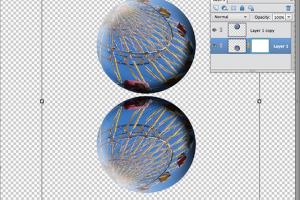Mastering Photoshop: A Comprehensive Guide to Create 3D Spheres

-
Quick Links:
- Introduction
- Understanding 3D Spheres
- Photoshop Setup for 3D Design
- Creating a 3D Sphere in Photoshop
- Adding Textures and Materials
- Lighting and Shadow Effects
- Rendering Your 3D Sphere
- Advanced Techniques for 3D Spheres
- Case Studies from Professional Designers
- Common Mistakes to Avoid
- FAQs
Introduction
Creating 3D spheres in Photoshop can elevate your graphic design projects, enabling you to add depth and realism to your digital art. Whether you’re a beginner or a seasoned designer, mastering this skill can greatly enhance your portfolio. In this guide, we will walk you through every step necessary to create stunning 3D spheres, covering essential techniques, tools, and tips to help you succeed.
Understanding 3D Spheres
A 3D sphere is a three-dimensional geometric shape that has a smooth surface and is perfectly round. In graphic design, 3D spheres can be used in various applications, from logos to illustrations and product visualizations. Understanding the basics of 3D modeling and rendering is essential for creating convincing spheres in Photoshop.
There are different types of 3D representations, including:
- Wireframe: Shows the basic structure of the sphere.
- Solid: Displays the filled-in volume of the sphere.
- Textured: Applies surface details, colors, and patterns.
Photoshop Setup for 3D Design
Before diving into the creation process, it’s crucial to set up your Photoshop workspace properly:
- Open Photoshop and create a new document (File > New).
- Select the appropriate dimensions for your project.
- Ensure that the 3D workspace is enabled by going to Window > Workspace > 3D.
Familiarize yourself with the 3D panel, allowing you to manage 3D objects, materials, and lights effectively.
Creating a 3D Sphere in Photoshop
Follow these detailed steps to create your first 3D sphere:
- Go to the 3D menu and select New 3D Extrusion from Selected Layer.
- Choose the Ellipse Tool from the toolbar to draw a circle on the canvas.
- With the circle selected, navigate to the 3D panel and adjust the extrusion depth to your preference.
- Use the 3D Rotate Tool to position your sphere as desired.
Make sure to save your work regularly!
Adding Textures and Materials
Textures can bring your 3D sphere to life. Here’s how to apply them:
- Select the sphere in the 3D panel.
- In the Properties panel, locate the Materials section.
- Choose a preset material or create a custom one by adjusting color, gloss, and reflection.
- Drag and drop your texture image onto the sphere.
Lighting and Shadow Effects
Lighting is critical for realistic 3D rendering. To set up lighting:
- Add a new light source via the 3D panel.
- Adjust the position and intensity of the light to create depth.
- Experiment with shadows by enabling shadow options in the properties panel.
Rendering Your 3D Sphere
Once you're satisfied with your sphere, it's time to render it:
- Go to 3D > Render 3D Layer.
- Choose your rendering options and quality settings.
- Click Render and wait for Photoshop to complete the process.
Advanced Techniques for 3D Spheres
For those looking to push their skills further, consider these advanced methods:
- Utilizing displacement maps for more complex textures.
- Combining multiple 3D objects into a single scene.
- Animating 3D spheres for video projects.
Case Studies from Professional Designers
Many designers have successfully integrated 3D spheres into their work. Here are a few examples:
- Product Visualization: A designer created a product mockup using a 3D sphere to showcase a new gadget.
- Logo Design: A branding expert used 3D spheres to add depth to a logo, enhancing its visual appeal.
Common Mistakes to Avoid
Even experienced users can stumble. Here are some common pitfalls:
- Ignoring lighting effects, which can flatten the design.
- Overusing textures, leading to a cluttered look.
- Neglecting to save versions of your project, risking loss of work.
FAQs
1. Can I create a 3D sphere in older versions of Photoshop?
3D functionality was introduced in Photoshop CS5. Ensure your version supports 3D features.
2. What file formats support 3D spheres?
Common formats include .OBJ, .3DS, and .DAE for 3D models.
3. How can I animate my 3D sphere?
Use the timeline feature in Photoshop to create frame-by-frame animations.
4. What are some good resources for 3D textures?
Websites like Textures.com and CGTextures offer extensive libraries.
5. Can I use 3D spheres in web design?
Yes, 3D spheres can be exported as images or used in animations for web applications.
6. Is there a way to create 3D spheres without a mouse?
While a mouse is recommended for precision, you can use keyboard shortcuts to navigate Photoshop.
7. How do I improve the quality of rendered images?
Increase the rendering quality settings in the 3D panel before rendering.
8. What are the system requirements for 3D in Photoshop?
A powerful graphics card with OpenGL support and sufficient RAM are essential for optimal performance.
9. How can I learn more about 3D modeling in Photoshop?
Consider online courses on platforms like Udemy or Skillshare.
10. Can I collaborate with others on 3D projects in Photoshop?
Yes, you can share PSD files or export models for collaboration.
Random Reads
- How to block sun from windows
- How to lubricate door hinges
- Reset apple account password
- Reset huawei router password
- Host website apache webserver
- How fix frozen unresponsive smartphone
- View downloaded files iphone
- Using kik on a computer
- How to add create use templates microsoft word
- Testing ground rod